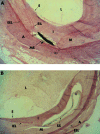A comparison of stent-induced stenosis in coronary and peripheral arteries
- PMID: 16473929
- PMCID: PMC1860405
- DOI: 10.1136/jcp.2004.025643
A comparison of stent-induced stenosis in coronary and peripheral arteries
Abstract
Background and objectives: Restenosis is a complication of interventional procedures such as angioplasty and stenting, often limiting the success of these procedures. Knowledge regarding the relative behaviour of different arteries after these procedures is limited, despite the extensive use of different vascular models. Although the results from studies using different vessels are analysed to predict the behaviour of coronary arteries and other vasculature, direct controlled comparisons between different arteries are necessary for a better understanding of the differential response to restenosis.
Methods: This study examines the response to stenting in coronary and internal iliac arteries as characterised by intimal hyperplasia and restenosis. In a swine model of in-stent stenosis, coronary arteries exhibited higher levels of intimal hyperplasia and per cent stenosis than internal iliac arteries.
Results: After normalisation for injury score, coronary arteries were found to undergo 47% more intimal hyperplasia (p<0.05), whereas per cent stenosis normalised for injury score tended to be higher (p = 0.01). Other measurements reflecting post-stenting intimal hyperplasia (maximal intimal thickness, medial area) did not exhibit significant differences between the artery groups.
Conclusions: These results show that coronary vessels are more prone to develop significant intimal hyperplasia and subsequent restenosis than internal iliac vessels. A better insight into how different arteries and arterial components behave is important in understanding and developing newer and better therapeutic measures for restenosis.
References
-
- Johnson G J, Griggs T R, Badimon L. The utility of animal models in the preclinical study of interventions to prevent human coronary artery restenosis: analysis and recommendations. On behalf of the Subcommittee on Animal, Cellular and Molecular Models of Thrombosis and Haemostasis of the Scientific and Standardization Committee of the International Society on Thrombosis and Haemostasis. Thromb Haemost 199981835–843. - PubMed
Publication types
MeSH terms
Grants and funding
LinkOut - more resources
Full Text Sources





